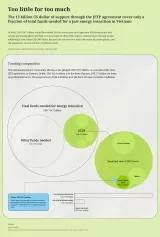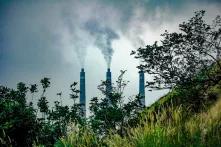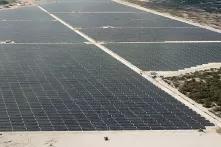
The purpose of Just Energy Transition Partnership (JETPs) is to decarbonize energy systems in emerging countries. In Vietnam, the partnership is ambitious but underfunded, unjust, and riddled with high political costs.

At the UN Climate Change Conference 2023 in Dubai (COP28), Vietnam’s Prime Minister Pham Minh Chinh presented a 200-page implementation plan for the Just Energy Transition Partnership (JETP). The partnership had been adopted in the previous year with an International Partners Group (IPG) and an alliance of financial institutions committed to climate neutrality (GFANZ). JETPs are primarily financial policy instruments whose declared purpose is to decarbonize energy systems in emerging countries that are heavily dependent on coal-based energy and threatened by climate change. The idea is to implement the energy transition in partnership in an equitable and inclusive approach regarding its social consequences. So far, partnerships have been concluded with countries of great geopolitical and geoeconomic importance for the donor side and whose energy systems rely heavily on fossil energies (alongside Vietnam, these countries are South Africa, Indonesia, and Senegal).
The energy transition partnership with Vietnam has pledged approximately 7.75 billion USD in public funding for energy transition projects at highly favorable terms, and approximately 7.75 billion UDS in private funding at market conditions for the period from 2023 to 2030
Fossil fuels such as coal and gas currently dominate Vietnam’s energy mix.
This will not change by 2030, on the contrary: Vietnam currently has 75 coal power plants and plans to build at least eight more. The country’s gas consumption is also expected to increase, including imported liquefied natural gas (LNG): The country plans to build 13 LNG power plants and seven LNG terminals by 2030. CO2 emissions are expected to peak in 2030.
As agreed in the JETP, however, the share of renewable energies in the energy mix is to attain up to 47 percent by 2030 (with the aim of reaching ca. 75 percent by 2050).
The 15 billion USD that are pledged in the JETP are a mere fraction of the total amount that Vietnam would require for its energy transition, estimated at 134.7 billion USD until 2030, and another 364 to 511 billion USD for the period from 2031 to 2050 (according to not entirely consistent calculations in the Power Development Plan).
There is a heated debate on how to raise the “remaining funds” beyond the 15 billion USD required for an energy transition that will initially be cost-intensive, but pay off later: The country’s ruling “party-state-business alliance” is engaged in protracted and difficult internal disputes over the direction of Vietnam’s future energy and economic policy. The PDP 8, a key element of national energy planning, underwent no fewer than a dozen different drafts and was not adopted until mid-2023 instead of the original timeframe of 2020/21.
The “Resource Mobilization Plan” and intended beneficiaries
The “Resource Mobilization Plan” (RMP) presented in December of 2023, lists the intended uses of the public funds that have been pledged to date. It includes a total of 400 possible projects, which have not yet been systematically prioritized or sufficiently specified. The plan does mention individual countries’ and the EU’s priorities for certain projects, but neither these priorities nor the private donors’ commitment to certain projects are carved in stone.
So far, the international donor community IPG has pledged 8.077 billion USD, of which 321.51 million USD are grants and 2.7 billion USD are loans on preferential terms. The lion’s share, 4.8 billion USD, consists of loans at market conditions. Vietnam had hoped and fought for a much larger share of grants and preferential loans, obviously to no avail.
The RMP names certain “priority” areas as well as “additional priorities” as beneficiaries of the pledged funds. It can be assumed that these different priorities reflect Vietnamese investment preferences, which in turn are influenced by certain influential corporate and political players, and a specifically Vietnamese understanding of compromise.
Following the structure of the body text in the “RMP,” the JETP Scheme Investment “Priorities” are as follows:
- Network infrastructure: On the one hand, this involves support for the state-owned company “Electricity Viet Nam” (EVN) to develop the electricity grid; on the other, mobilizing private investment to expand the grid; and creating an appropriate legal framework.
- Develop energy storage capabilities and pumped-storage power plants: The aim here is to modernize the energy storage system (ESS), develop a political and legal framework for it, and invest in pilot projects for battery storage systems (BESS).
- Support for offshore wind energy: This proposal involves building capacity and providing technical assistance to ministries and other organizations, in particular, to develop a policy for maritime spatial planning, as well as financial assistance for the first offshore wind projects (a total of twelve wind power plants with up to 6 GW are to be built and connected to the grid by 2030).
The “Additional Investment Priorities” include proposals for projects and investments to
- increase energy efficiency (EE) and reduce electricity demand.
- ramp up solar energy (in addition to existing plants, solar is expected to generate 25 to 30 GW by 2030) and finalizing and implementing rules for the direct purchase of electricity (DPPAs) to allow commercial and industrial customers to purchase solar power directly from external providers; introducing surplus tariffs for rooftop and multiple land-use solar Photovoltaic (PV) systems, among other things.
- reduce coal-fired power generation by “restructuring” coal power plants with fixed, long-term “Power Purchase Agreements"(PPAs) “to incentivize flexibility, debt restructuring, and raising public finance to compensate losses”. Furthermore, the plan proposes to “allow pilot tests for improved operational efficiency and flexibility of four to five coal power plants using different types of coal and technology” (RMP, p. 113)). Coal power plants are supposed to function as a sort of backup and “can thus make room for the renewables, leading to reduced consumption of coal and CO2 emissions.” (RMP, p. 113)
Placed prominently at the top of a list of 400 possible projects, but not mentioned under either of the priorities, is the proposed construction of 20 hydropower plants with a capacity of 3.6 GW (16 medium-sized plants and four small plants). Another proposition from the list that is also not classified as a priority is to convert coal power plants to the use of biomass, green ammonia, and hydrogen as well as other operating modes that are yet to be technologically and economically tested.
Evaluation of the “Resource Mobilization Plan”
The RMP addresses central issues surrounding the energy transition in Vietnam: restructuring and renewal of the currently inadequate electricity grid; the problem of storage options and technologies; and control and regulation technologies. All of this is essential for harnessing renewables such as solar and wind. The focus on energy efficiency, which is often deficient in Vietnam, also demonstrates a sound and context-appropriate setting of priorities.
Since the pledged funds are far from sufficient to achieve these objectives, Vietnam also seeks to attract private investors, or even outsource certain endeavors to private investors entirely. This requires a specific political and legal framework and concrete legal and other guidelines. Vietnam also plans to launch numerous “Technical Assistance Projects” to create and develop such guidelines and frameworks, which is also reasonable and appropriate to the context.
However, all these projects are but a first step towards solving the underlying problems because developing frameworks and guidelines is not only a complex and lengthy process but also highly controversial. This is evident in the protracted and ongoing disputes over general plans and rules for “Direct Power Purchase Agreements” (DPPAs, the first model trial of which was set to begin in 2022; for “Power Purchase Agreements” (PPAs); and the utter lack of progress regarding maritime spatial planning. After all, this is not just about investing scarce resources, but ultimately also about who can and should operate in and make a profit off the emerging business field of “renewable energy generation and distribution,” which promises to be profitable in the future.
Vietnam’s legal, economic, and political setup poses additional crucial challenges. Firstly, the Communist Party and its government want to keep electricity prices low compared to the rest of the region. Secondly, EVN wants to retain its monopoly on electricity distribution as well as its strong position in the energy generation market. Neither of these factors necessarily heighten the appeal of the Vietnamese market for domestic and foreign investors. The situation is also complicated for EVN, as the electricity price ceiling keeps causing the utility company enormous losses: Between 2021 and 2023 alone, EVN accumulated a loss of 2.3 billion USD, forcing the state to raise electricity prices twice.
It is therefore doubtful whether Vietnam is able or willing to even begin to initiate its energy transition and tackle problems such as grid conversion and expansion with the support of the IPG and the GFANZ by 2030. The fact that the country is planning workarounds, such as exporting energy generated by offshore wind power pilot projects to Singapore and elsewhere via an underwater transmission line (thus circumventing the necessary overhaul of Vietnam’s electricity grid) and/or importing electricity from 26 hydropower plants in Laos raise doubts about the responsible parties’ willingness to take the necessary action. In that vein, the RMP states:
“CFPP phase-out at large scale in Vietnam is not feasible in the near-term, but some older CFPPs may be able to transition to alternative energy sources and uses, for which transactions could be piloted.” (RMP, p. 65)
Environmentalists have been critical of such plans, and economists agree. Ultimately, neither the government’s PDP 8 nor the JETP with Vietnam offer any suggestions on how to persuade the operators of relatively “young” coal power plants (Vietnam’s coal power plants are seven years old on average) to decommission their plants, or how to compensate them. No form of “restructuring” and overhauled “operation strategies” alone will suffice to solve the problem of “decommissioning and compensation” – if Vietnam truly wants to phase out coal-based power generation in the first place.
In addition, the preference for expanding hydropower plants and the comparatively swift pathway towards importing LNG suggest that key players in state-owned companies such as Petrovietnam and Petrolimex, as well as in certain ministries, continue to rely on “tried and tested” technologies like hydropower and fossil fuels, namely gas and coal. The government officially describes LNG as a kind of “bridging technology” that is to be replaced by hydrogen in 2035.
There is also a risk that EVN and state-owned companies such as Petrovietnam, Petrolimex, Vinacomin, and other companies might be playing a kind of double game: The JETP, in particular, offers them an easy way to produce some “clean” energy and boost their image as “green” corporations, while at the same time, they continue to rely on fossil-based energy. There might even be some kind of “greenwashing” at play: Fuel supplier Petrolimex, for example, has proposed a project under which the company would continue to sell gas while equipping its more than 2,700 gas stations with solar panels to cover their own electricity consumption. Petrovietnam proposes using wind turbines to power its exploration of oil and gas deposits.
Based on briefing notes by UK officials and their observations of discussions about the RMP, recent reports suggest that the Ministry of Natural Resources and Environment (MoNRE) is politically weak. At the same time, not only providers of fossil fuels such as Petrovietnam, Petrolimex, and Vinacomin, but also representatives of various ministries, including Trade and Industry (MoIT), Finance (MoF), and Planning and Investment (MPI), are hindering the expansion of renewable energies by engaging in “persistent obstructionism,” “foot-dragging,” as well as “blockages and bureaucracy”. “Vietnam’s cross-government consensus on efforts to fight climate change” is becoming “increasingly fragile,” the British diplomats’ notes said. Both a press release from British government circles and the authors of the RMP describe it as “a ‘living’ document, updated regularly implementation progresses” (RMP, p. 2). This wording at the very least implies the option of effectively slowing down the energy transition in Vietnam.
Lastly, there is the question of whether all or at least most of the 400 proposed projects of the RMP are true drivers or even “game changers” in the energy transition. Wouldn’t less have been more, for instance, by agreeing on a few “lighthouse projects” in areas like grid infrastructure and storage and control technology? Wouldn’t the success of these projects have encouraged key players in the energy transition in Vietnam and put a damper on those who would cling to fossil energy?
“Just Transition” and “political costs”: An energy transition without environmentalists
In Vietnam, “just” is understood almost exclusively in a social sense – including, first of all, the objective of keeping electricity prices low, for example in remote regions and for very poor ethnic minorities. Another aspect is employment prospects for workers in coal-fired plants for the time after coal is phased out. However, this does not mean that workers and representatives of ethnic minorities have a say or even get to participate in a (self-)organized manner. in the 200-page RMP the word “NGO” appears only once (p. 90). In fact, NGOs are no longer able to make their voices heard in the field of energy transition: In the past two years, five environmental, land rights, and civil rights activists and one prominent energy expert (the “Vietnam Six”) were arrested and some of them sentenced to long prison terms. Five out of the six people arrested or convicted actors are accused of tax offenses. “Project 88” has issued a detailed analysis, condemning the accusations as contrived and politically motivatedThe political motives for the arrests are the subject of speculation.1 ..
These arrests and convictions are in stark contradiction to the “consultations” that were agreed in the JETP with Vietnam, which stipulated that NGOs and other civil society organizations be consulted in implementing the energy transition. When the RMP was presented in Dubai, there was no mention, let alone any criticism of the arrests, convictions, and other “political costs”. On the contrary, the RMP was praised effusively by top representatives of the EU, Canada, the UK, and Norway, as well as the “US Special Presidential Envoy for Climate,” John Kerry.
Human rights and climate activists have pointed out that without the active participation of environmental activists, neither the proper use of public and other funds can be guaranteed, nor could the Vietnamese government be held accountable if promises were broken.
A void where gender equality should be
As 70 countries recently confirmed at COP28, a “just” energy transition also includes greater involvement of women and girls in the transformation processes. This would accelerate progress towards the goal of a healthier, fairer, and safer world. However, there are only a few references to gender equality in the JETP, and even fewer in the RMP, which merely contains one passage about “strengthen[ing] gender equality in work, jobs, and career change” (RMP, p. 46-49) in the methodological notes on prioritization criteria. However, not a single one of the 400 proposed projects has a recognized gender-specific focus.
Conclusion
The agreement to support Vietnam in its energy transition is ambitious. With three investment focus areas designated as “priorities,” it is focused on solving key problems in the energy transition. But mentioning “additional priority” areas of investment leads down the wrong path. The vast majority of the proposed projects in the area of “phasing out coal-fired power generation” were likely added under pressure from certain players who want to see a different kind of energy transition, if they want one in the first place: It is easy to identify corporate interests on the part of Petrovietnam, Petrolimex, Vinacomin, EVN, various banks, and their representatives in ministries such as MoIT, MoF, and MPI.
The compromise of classifying projects into “priority” and “additional investment priority” indicates that the negotiations between the Vietnamese side and the IPG and the GFANZ failed to define the “priorities” in the first phase of the energy transition. It seems that on the Vietnamese side, neither the staunch advocates nor the stark opponents of the energy transition were able to fully assert themselves. The Vietnamese side did, however, win out over the donors. Its vague prioritization is a manifestation of Vietnamese actors’ very specific understanding of compromise, by which no one yields or concedes anything, and no one is prepared to engage in any open conflict or a serious and open-ended exchange about diverging objectives. This has resulted in “combinations and syntheses of different ideas and goals” that are simply juxtaposed2 .
With the RMP, by classifying investment priorities, and even more so, by listing and classifying 400 possible investment projects labeled as “priority” and “additional priority,” both the IPG and the GFANZ seem to have fully acquiesced to this understanding of compromise. In doing so, they have accepted the fact that there will be investments in projects that counteract the energy transition and/or will be unprofitable in the medium and long term.
Clearly, Germany and Vietnam entertain very different ideas about what makes a “just” energy transition. At least in Germany, a just energy transition means involving NGOs in the processes leading to it, as was agreed in the 2022 partnership. But beyond voicing objections, the IPG has no means of response if the partner country fails to involve NGOs, or worse, when representatives of environmental NGOs and energy policy experts are imprisoned for years and NGOs cease their activities for fear of state repression.
The fact that Germany, a declared advocate of “feminist foreign policy,” does not insist on concrete gender equality projects, reinforces the impression that the “Just Energy Transition Partnership with Vietnam” may profess ambitious goals, but is underfunded, perhaps not all that well-conceived, and offers little leverage to enforce consistent implementation. Without such leverage, however, the credibility of Germany’s “values-driven policy” might suffer permanent damage given the partnership’s high “political costs”.
Please note: An extended version of the analysis is available from the author.
Translated by: Kerstin Trimble.
- 1 Neither the government nor the NGOs comment on them (anymore), or only in veiled terms. The most forthright statements imply that five of the “Vietnam Six” were arrested for their membership in the “Vietnam Sustainable Energy Alliance” (VSEA), which had become a threat to the policies of the “party-state-business alliance”: For example, the VSEA revealed government plans to expand coal-fired power generation while that same government publicly announced Vietnam’s path toward climate neutrality. The authorities claim that the charges and convictions are of a purely fiscal nature. However, the arrest of Dr. Nhien (“Vietnam Initiative for Energy Transition,” or VIETSE) was probably meant as a warning signal, not only to political activists but also to experts, to stay out of energy policy and disputes over the use of billions of US dollars. If the government’s intention was for such punishments to act as a deterrent, they succeeded: “Green ID,” “Change,” and other Civil Society Organizations have partially or entirely ceased their activities. The think tank VIETSE, registered as a “business,” has “paused” its activities. It is unknown whether other energy experts have already turned to other fields of work
- 2Wischermann, Jörg; Civil Society Action and Governance: Selected Findings from an Empirical Survey, in: Journal of Southeast Asian Affairs, 2/2010, p.24f and p.35





